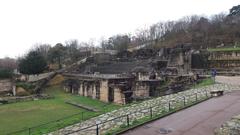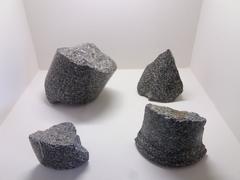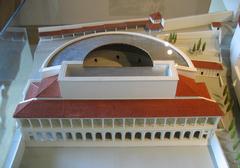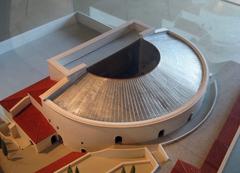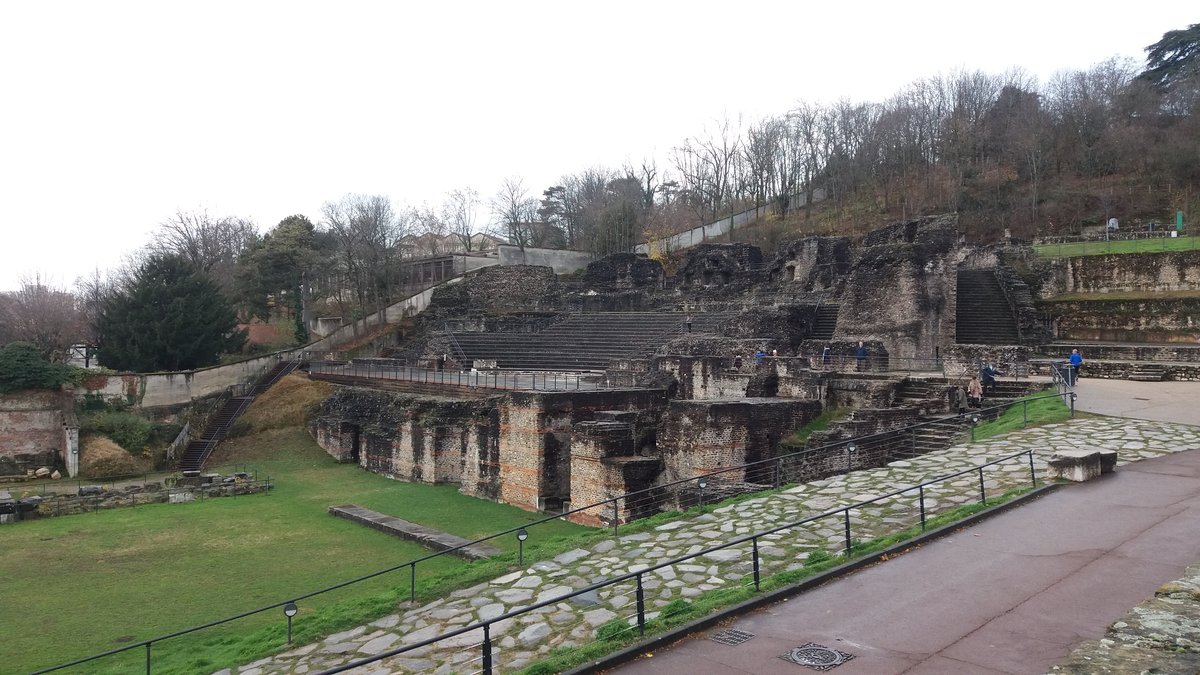
Odeon of Lyon: Visiting Hours, Tickets, and Historical Site Guide
Date: 14/06/2025
Introduction
Perched on the historic slopes of Fourvière Hill, the Odeon of Lyon is a masterful relic of Roman architecture and a vivid testament to Lyon’s origins as the capital of Roman Gaul. Built in the early 2nd century CE, likely under Emperor Hadrian, the Odeon was an intimate venue for music, poetry, and oratory, serving as a cultural counterpoint to the larger Grand Roman Theatre nearby. Today, this remarkable site continues to blend antiquity with modern vibrancy, hosting contemporary festivals and welcoming visitors from around the globe (French Moments; Atlas Obscura; Lugdunum Museum).
This guide provides a comprehensive overview for those planning a visit: from historical context and architectural highlights to practical tips on admission, accessibility, and nearby attractions. Whether you are a history enthusiast, culture seeker, or traveler in Lyon, this article will help you make the most of your exploration.
Table of Contents
- Introduction
- Roman Lyon and the Origins of the Odeon
- Architectural Features and Construction
- Function and Social Role
- Decline, Rediscovery, and Restoration
- Visitor Information
- Nearby Attractions and Suggested Itineraries
- Frequently Asked Questions (FAQ)
- Conclusion
- References
Roman Lyon and the Origins of the Odeon
Founded as Lugdunum in 43 BCE, Lyon became the administrative and cultural center of Roman Gaul. Its strategic position at the Rhône and Saône rivers fostered rapid urban development, including monumental public works such as theatres, baths, and temples (French Moments).
The Odeon, constructed in the early 2nd century CE, was part of a broader expansion reflecting the city’s prosperity. While the neighboring Grand Roman Theatre accommodated dramatic spectacles for up to 10,000 spectators, the Odeon’s more intimate 3,000-seat arrangement catered to musical performances, poetry readings, and oratorical contests (Atlas Obscura; Lugdunum Museum).
Architectural Features and Construction
Layout and Capacity
The Odeon measures approximately 73 meters in diameter and consists of a semi-circular cavea (seating area), an orchestra adorned with colored marbles, and a stage backed by an ornate wall (scaenae frons). The building’s orientation and integration into the hillside not only optimized acoustics but also reflected advanced Roman engineering (French Moments).
Materials and Decoration
The orchestra pavement features lavish inlays of marble sourced from across the Roman Empire—green porphyry from Greece, red porphyry and granite from Egypt, and yellow marble from Africa. Such opulence underscored Lugdunum’s status and the Odeon’s civic importance (Lugdunum Museum).
Roofing and Acoustics
Unlike most open-air theatres, the Odeon was likely covered with a timber roof, enhancing both its acoustics and year-round usability—a rarity in the western provinces (Fête des Lumières).
Engineering
Roman engineering prowess is evident in the Odeon’s substructures—vaulted supports beneath the seating, sophisticated drainage systems to manage rainwater, and careful adaptation to the sloping terrain (Charcotrip).
Function and Social Role
The Odeon served as the intellectual and artistic heart of Roman Lugdunum. Unlike the larger theatre, it hosted refined cultural gatherings for the city’s elite—concerts, recitals, and oratory competitions. Its rarity in Gaul (with only a few known examples, such as in Vienne and Valence) further highlights Lyon’s regional prestige (Lugdunum Museum).
In addition to performances, the Odeon may have accommodated official assemblies, reinforcing its role in civic life. Its proximity to other public buildings underscores its integration into the administrative and ceremonial fabric of ancient Lyon (French Moments).
Decline, Rediscovery, and Restoration
As the Roman Empire waned in the 4th and 5th centuries, the Odeon fell into disuse and was gradually quarried for building materials. Despite this, parts of the structure remained visible, hinting at its prior grandeur (Lugdunum Museum).
Systematic archaeological excavations began in the 20th century, notably from 1933 onward. Restoration efforts have since stabilized and partially reconstructed the site, which now forms part of the Fourvière Archaeological Park. The adjacent Lugdunum Museum displays artifacts and provides interpretive resources (French Moments).
Visitor Information
Visiting Hours
- Odeon and Archaeological Park: Open daily, typically from 10:00 AM to 6:00 PM, with summer hours extended until 7:00 PM. Hours may vary for special events; check the Lugdunum Museum website for updates.
- Museum: Usually open 11:00 AM–6:00 PM (closed Mondays).
Tickets and Admission
- Archaeological Park: Free general admission to the Odeon and Grand Roman Theatre remains.
- Museum: Entry fee (approx. €6 for adults, reduced rates for students and children; free on the first Sunday of each month).
- Combined tickets: Available for museum and site, including guided tours (Visiter Lyon).
- Festival events: Tickets required for performances during “Les Nuits de Fourvière” (en.visiterlyon.com).
Accessibility
- The site is partially accessible, with ramps and pathways suitable for visitors with reduced mobility. Some areas have uneven stone surfaces; contact the visitor center for specific assistance (Lugdunum Museum).
Getting There and Travel Tips
- Public Transport: Fourvière funicular (F2 line) from Vieux Lyon metro station to Fourvière stop.
- On Foot: Scenic routes available from Old Lyon, though the ascent is steep.
- Visitor Services: Restrooms, gift shop, and café at the museum; interpretive panels and virtual tours accessible online (Charcotrip).
Tips for Visiting:
- Wear sturdy shoes for uneven terrain.
- Bring water and sun protection in summer; limited shade.
- Arrive early or outside festival season for a quieter experience.
- Consider the Lyon City Card for combined site, museum, and transport access (shop.visiterlyon.com).
Special Events and Guided Tours
- “Les Nuits de Fourvière”: Annual summer festival featuring music, theatre, and dance in the Odeon and Grand Theatre (en.visiterlyon.com).
- Guided Tours: Available via the museum or local operators, often in multiple languages; booking recommended.
Nearby Attractions and Suggested Itineraries
- Grand Roman Theatre: Directly adjacent, offering a complementary archaeological experience.
- Lugdunum Museum: Houses artifacts, mosaics, and multimedia exhibits on Lyon’s Roman past.
- Basilica of Notre-Dame de Fourvière: Iconic church with panoramic city views.
- Vieux Lyon (Old Lyon): Renaissance district with traboules (hidden passageways), shops, and restaurants.
- Place Bellecour: Major city square, central for public transport and city exploration.
Suggested Itinerary:
Morning: Explore Odeon and Grand Theatre → Museum visit
Afternoon: Walk through Vieux Lyon → Basilica of Fourvière → Evening festival or city stroll
Frequently Asked Questions (FAQ)
Q: What are the Odeon of Lyon visiting hours?
A: The archaeological park is typically open daily 10:00 AM–6:00 PM (until 7:00 PM in summer). Museum hours differ; check the official website.
Q: Is entry to the Odeon free?
A: Yes, general entry to the archaeological park is free. Museum or festival events require tickets.
Q: Are guided tours available?
A: Yes, in multiple languages; book through the museum or Lyon Tourist Office.
Q: How do I get to the Odeon from the city center?
A: Use the Fourvière funicular from Vieux Lyon, or walk (steep climb).
Q: Is the site accessible for people with disabilities?
A: Partially; ramps available, but some areas have ancient stone steps. Contact ahead for assistance.
Q: When is the best time to visit?
A: Summer for festivals; early mornings or weekdays for fewer crowds.
Q: What else can I see nearby?
A: Grand Roman Theatre, Lugdunum Museum, Basilica of Notre-Dame de Fourvière, and Old Lyon.
Conclusion
The Odeon of Lyon is a living monument—blending Roman architectural brilliance, rich cultural history, and contemporary vibrancy. Its well-preserved mosaics, innovative design, and ongoing use in festivals like “Les Nuits de Fourvière” make it a must-visit for anyone in Lyon. Whether exploring ancient ruins, attending a performance, or simply enjoying the panoramic views, visitors will find the Odeon a gateway to Lyon’s storied past and dynamic present.
For up-to-date information, virtual tours, and guided audio experiences, visit the Lugdunum Museum official site or the Lyon Tourist Office. Download the Audiala app for enhanced audio guides and follow Lyon’s cultural events on social media.
References
- French Moments
- Atlas Obscura
- Lugdunum Museum
- Visiter Lyon
- Traveltolyon.com
- History Hit
- Charcotrip
- Fête des Lumières
- My French Life
- en.visiterlyon.com
- UNESCO World Heritage
- shop.visiterlyon.com
- Audiala
